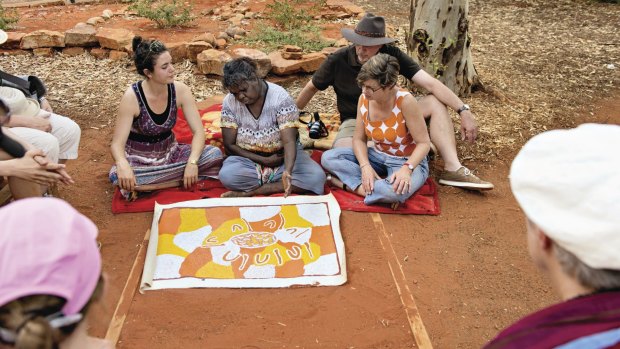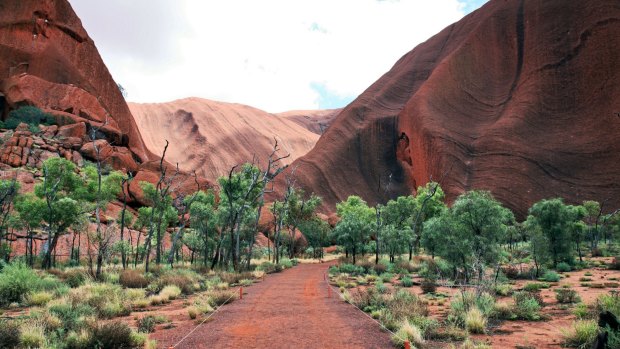This was published 2 years ago
Indigenous art at Uluru: Visitors back to pay homage to the rock star
By Jane Reddy

A dot painting workshop with local Indigenous artists.
It's impossible for there ever to be an ordinary day at the extraordinary Uluru.
Standing in the shadows of the sandstone monolith close to the base, my neck cranes to take in as much of the rock, estimated to weigh 1,425,000,000 tonnes, as I can. It's hard to argue against the sheer greatness of this natural wonder - even at a distance it is a constant presence.
It is why, until COVID and subsequent closures, busloads of visitors would line up for seats on sunrise and sunset tours to this place that drew more than 250,000 Australian and overseas visitors annually. Uluru reopened to domestic travellers in August.

Uluru inspires wonder and art.
Before getting up close to the rock I sit near Sarah Dalby, an Anangu artist and traditional custodian/landowner of Uluru, who leads a traditional dot painting workshop.
Wind begins to gust our canvas underneath as Sarah's interpreter, Cara Munn, lets out a knowing chuckle. "Sarah said to me this morning there's clouds coming and the big winds are coming they're bringing the clouds and that's exactly what's happening," she says.
Sarah speaks Pitjantjatjara a hypnotic dialect of the Western Desert. One of its words - ngangkari - meaning an Indigenous practitioner of bush medicine or healer was added to the Macquarie Dictionary in 2019 receiving an honourable mention for Word of the Year in the same year.
The Macquarie committee noted of ngangkari: "It's lexically notable and refreshing because, unlike many borrowings from Indigenous languages, it is straight from Pitjantjatjara – it hasn't been translated, Anglicised, or otherwise changed."
Sarah explains the traditional Indigenous tools for men and women; first up it's the kali which looks like a boomerang but it's not.
"It's made from the acacia tree and it's used for hunting," Sarah says.
"It's only meant to go one way and the men will hunt things like bush turkey. It will hit the leg or hit the wing so then you can go and catch it. But iIt won't come back to you so you hope you'll hit it straight away."
The kali is multifunctional and during a ceremony men will clap two together to make that drumming beat.
A wirra or piti bowl, carved from a bloodwood tree, a type of local eucalyptus, is then passed around.
"It's a kind of women's shopping bag - bush tomatoes, bush figs, bush plums, lizards, lizard eggs as well as carrying little babies - one on their head and one in the piti bowl and away they go. Some are made with higher walls to carry water."
In the red sand Sarah draws circles with her finger. The big circles in the middle represent Uluru, Kata Tjuta and Attila,100 kilometres down the road, and the travelling lines to and from these places.
"The old way of doing things and teaching was in the sand and in the caves and when you go for a wander you will see all the beautiful paintings and these days the artists get to teach on beautiful canvas," she says.
Given our own canvases, I try my hand at painting Ngura, circles which represent home, and Iwara - circles with horizontal lines either side to show travel.
Sarah draws a familiar and far more sophisticated scene from earlier in the day, a lizard, and not just your run-of-the-mill sand goanna but a perentie lizard, the largest in Australia.
"This morning Sarah and I got some coffee from the base of the climb and the whole way [were the tracks of] the tail and the feet and we followed it for about 40 metres and then it disappeared," Cara says.
"It could be anywhere - it could be eating a tourist."
Sarah laughs before correcting the translator "They eat rabbits not tourists."
Jane Reddy travelled as a guest of Voyages and Jetstar.
THE DETAILS
MORE
traveller.com.au/uluru; Voyages.com.au; ayersrockresort.com.au; northernterritory.com; jetstar.com/au
PAINT
Daily dot painting workshops are run by the not-for-profit Maruku Arts at Yulara town square. Costs: $72 for adults, $36 for children and $198 for families (two adults and two children).
EAT
Returning to the resort for the seventh season is under-the-stars dinner Tali Wiru. The intimate experience is for 20 guests each night atop a sand dune overlooking Uluru and Kata Tjuta. From $380 a person.
SEE
Walk among the Field of Light Uluru by artist Bruce Munro covers more than seven football fields and has 50,000 spindles of light in desert colours of ochre, violet, blue and white.
STAY
Rooms at Ayers Rock Resorts Sails in the Desert cost from $230 a night for two nights.
FLY
Jetstar flies from Melbourne and Sydney to Ayers Rock Airport four times a week.
Sign up for the Traveller Deals newsletter
Get exclusive travel deals delivered straight to your inbox. Sign up now.